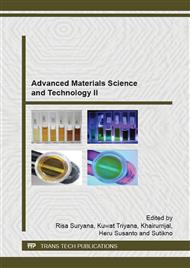p.119
p.123
p.127
p.131
p.135
p.140
p.147
p.151
p.155
The Effect of Mixing Time on the Morphology and Mechanical Properties of Imperata cylindrica Cellulose
Abstract:
One application of cellulose is for the isolation of steam distribution pipe. Many researchers on cellulose for isolation have been conducted due to a popular issue of energy saving with its fairly cheap treatment cost. Cellulose is produced from imperata cylindrica reed by an extraction process. The results of extraction were in a form of cellulose fibers. To make the test easier, the cellulose fibers were made in a form of sheets by adding 3.5 % Na-CMC (Sodium Carboxyl Methyl Cellulose). The sheets are produced by blending for 30, 45, and 60 minutes and then put it into the oven with temperature of 40°C for 36 hours. Tests were conducted for four parameters, namely, density, tensile strength, elasticity modulus, and morphology. The density was measured by picnometer, while the tensile strength and elasticity modulus was measured by UCT-5T Model UTM, and the morphology was measured by optical microscope from Nikon Ephipot. The test showed : minimal and maximal densities were 166.7 kg/m3 and 550.2 kg/m3, respectively; minimal and maximal average tensile strengths were 9.16 MPa and 10.5 MPa, respectively; minimal and maximal elasticity modulus were 79.948 MPa and 113.09 MPa, respectively; and minimal and maximal specific tensile strengths were 0.01665 MPa/(kg/m3) and 0.06289 MPa/(kg/m3).
Info:
Periodical:
Pages:
135-139
Citation:
Online since:
August 2015
Authors:
Price:
Сopyright:
© 2015 Trans Tech Publications Ltd. All Rights Reserved
Share:
Citation:


